Assignment On Montresor Skilfully Employs Reverse Psychology
VerifiedAdded on 2022/10/04
|7
|1470
|14
Assignment
AI Summary
Contribute Materials
Your contribution can guide someone’s learning journey. Share your
documents today.
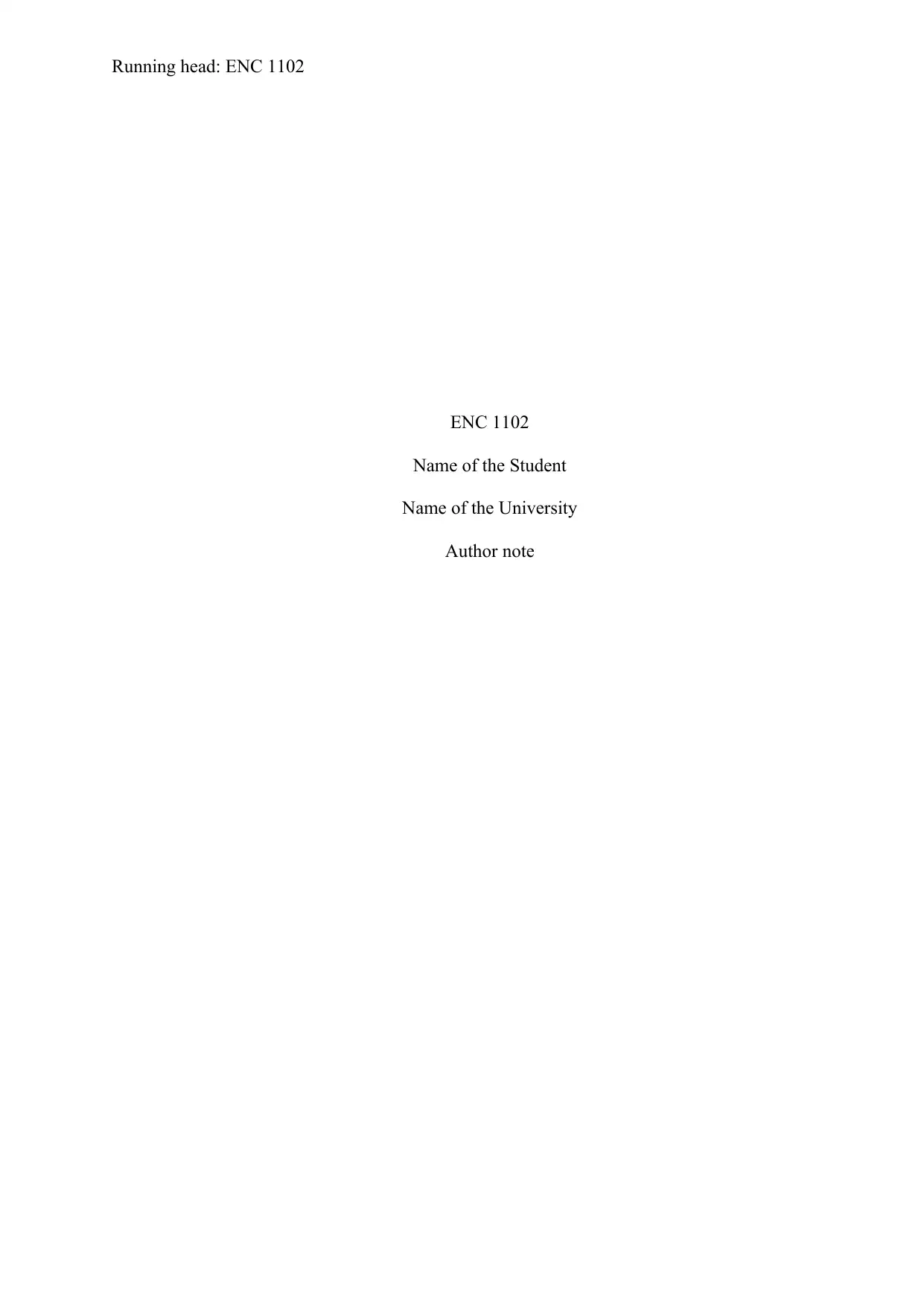
Running head: ENC 1102
ENC 1102
Name of the Student
Name of the University
Author note
ENC 1102
Name of the Student
Name of the University
Author note
Secure Best Marks with AI Grader
Need help grading? Try our AI Grader for instant feedback on your assignments.
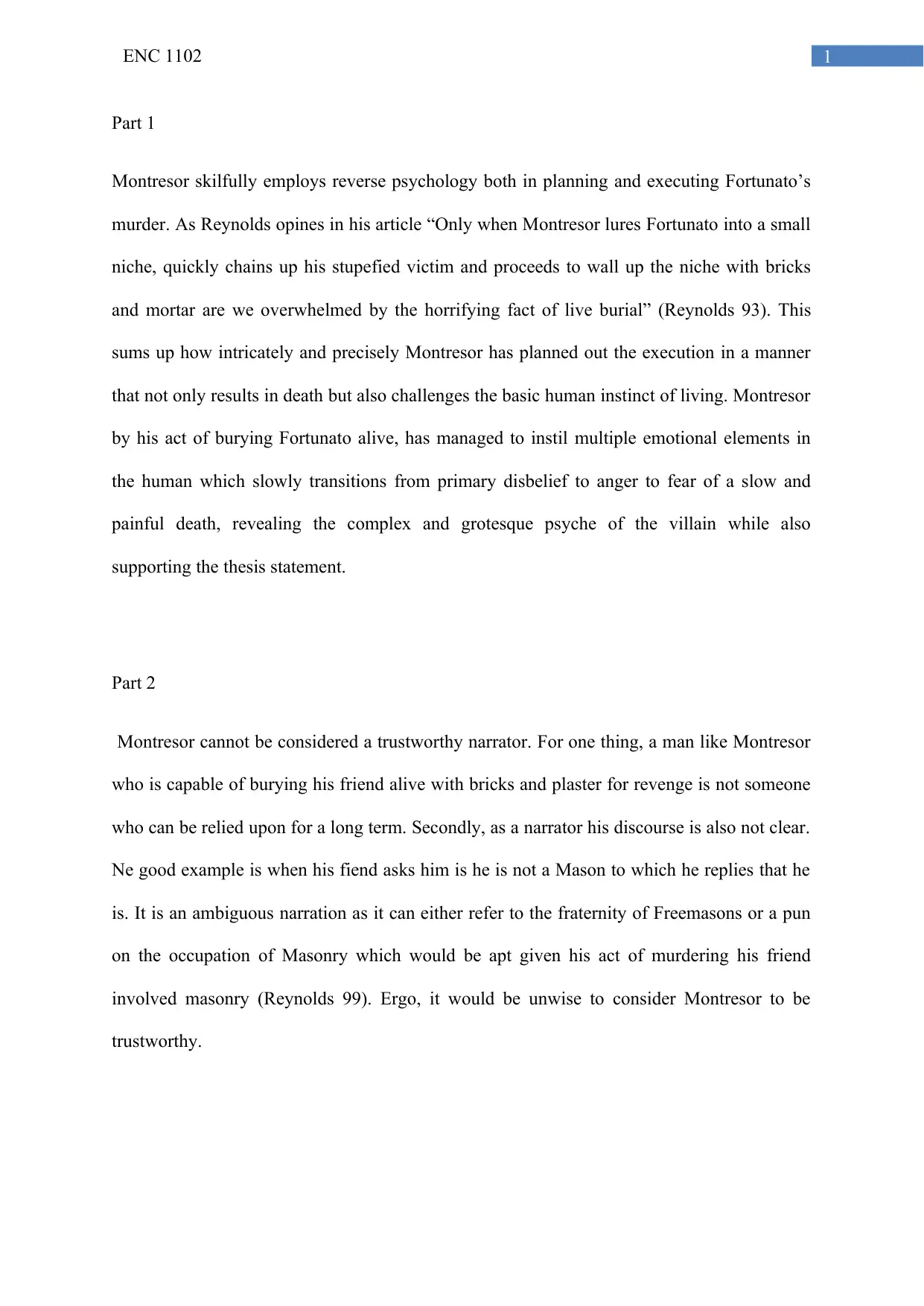
1ENC 1102
Part 1
Montresor skilfully employs reverse psychology both in planning and executing Fortunato’s
murder. As Reynolds opines in his article “Only when Montresor lures Fortunato into a small
niche, quickly chains up his stupefied victim and proceeds to wall up the niche with bricks
and mortar are we overwhelmed by the horrifying fact of live burial” (Reynolds 93). This
sums up how intricately and precisely Montresor has planned out the execution in a manner
that not only results in death but also challenges the basic human instinct of living. Montresor
by his act of burying Fortunato alive, has managed to instil multiple emotional elements in
the human which slowly transitions from primary disbelief to anger to fear of a slow and
painful death, revealing the complex and grotesque psyche of the villain while also
supporting the thesis statement.
Part 2
Montresor cannot be considered a trustworthy narrator. For one thing, a man like Montresor
who is capable of burying his friend alive with bricks and plaster for revenge is not someone
who can be relied upon for a long term. Secondly, as a narrator his discourse is also not clear.
Ne good example is when his fiend asks him is he is not a Mason to which he replies that he
is. It is an ambiguous narration as it can either refer to the fraternity of Freemasons or a pun
on the occupation of Masonry which would be apt given his act of murdering his friend
involved masonry (Reynolds 99). Ergo, it would be unwise to consider Montresor to be
trustworthy.
Part 1
Montresor skilfully employs reverse psychology both in planning and executing Fortunato’s
murder. As Reynolds opines in his article “Only when Montresor lures Fortunato into a small
niche, quickly chains up his stupefied victim and proceeds to wall up the niche with bricks
and mortar are we overwhelmed by the horrifying fact of live burial” (Reynolds 93). This
sums up how intricately and precisely Montresor has planned out the execution in a manner
that not only results in death but also challenges the basic human instinct of living. Montresor
by his act of burying Fortunato alive, has managed to instil multiple emotional elements in
the human which slowly transitions from primary disbelief to anger to fear of a slow and
painful death, revealing the complex and grotesque psyche of the villain while also
supporting the thesis statement.
Part 2
Montresor cannot be considered a trustworthy narrator. For one thing, a man like Montresor
who is capable of burying his friend alive with bricks and plaster for revenge is not someone
who can be relied upon for a long term. Secondly, as a narrator his discourse is also not clear.
Ne good example is when his fiend asks him is he is not a Mason to which he replies that he
is. It is an ambiguous narration as it can either refer to the fraternity of Freemasons or a pun
on the occupation of Masonry which would be apt given his act of murdering his friend
involved masonry (Reynolds 99). Ergo, it would be unwise to consider Montresor to be
trustworthy.
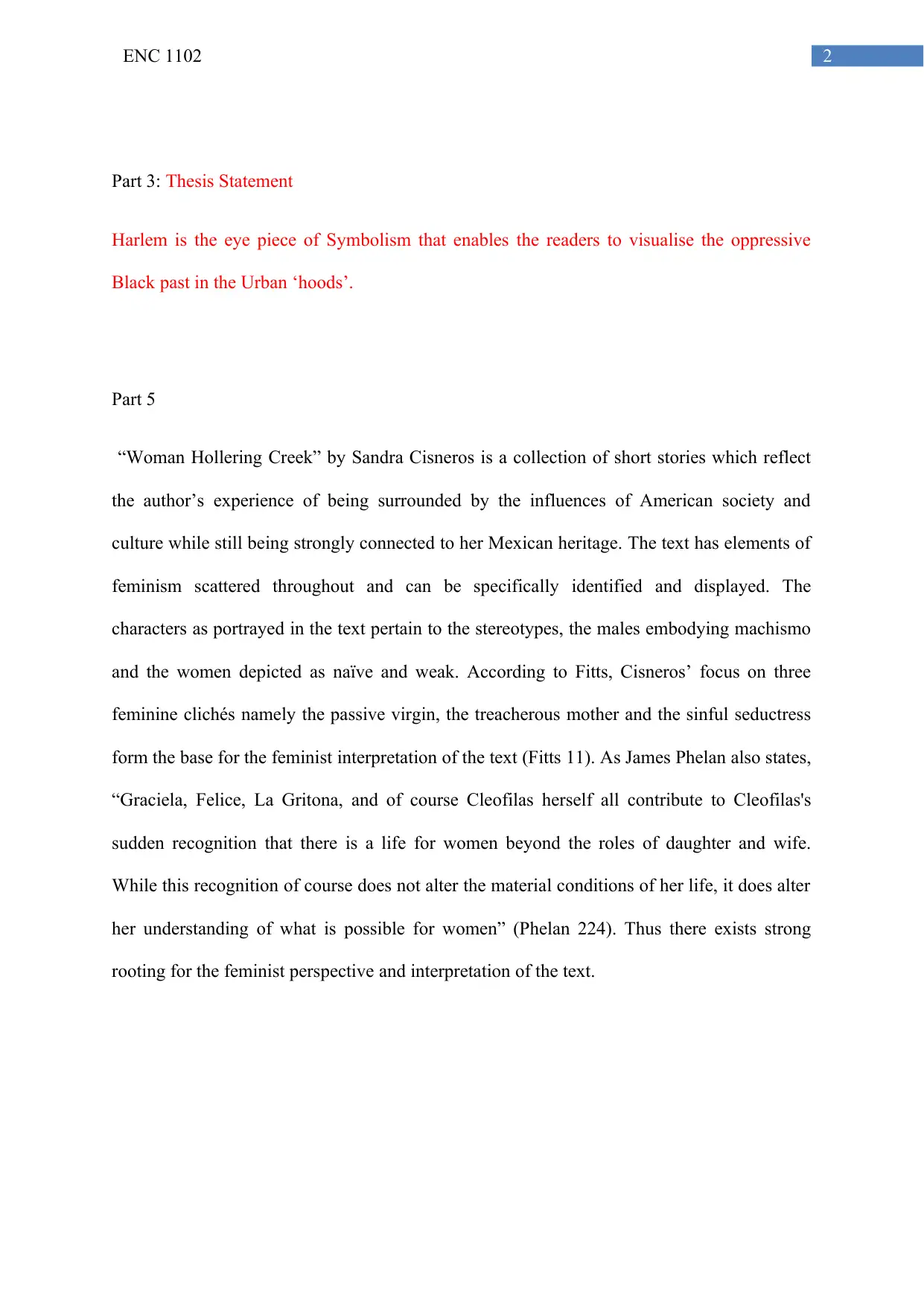
2ENC 1102
Part 3: Thesis Statement
Harlem is the eye piece of Symbolism that enables the readers to visualise the oppressive
Black past in the Urban ‘hoods’.
Part 5
“Woman Hollering Creek” by Sandra Cisneros is a collection of short stories which reflect
the author’s experience of being surrounded by the influences of American society and
culture while still being strongly connected to her Mexican heritage. The text has elements of
feminism scattered throughout and can be specifically identified and displayed. The
characters as portrayed in the text pertain to the stereotypes, the males embodying machismo
and the women depicted as naïve and weak. According to Fitts, Cisneros’ focus on three
feminine clichés namely the passive virgin, the treacherous mother and the sinful seductress
form the base for the feminist interpretation of the text (Fitts 11). As James Phelan also states,
“Graciela, Felice, La Gritona, and of course Cleofilas herself all contribute to Cleofilas's
sudden recognition that there is a life for women beyond the roles of daughter and wife.
While this recognition of course does not alter the material conditions of her life, it does alter
her understanding of what is possible for women” (Phelan 224). Thus there exists strong
rooting for the feminist perspective and interpretation of the text.
Part 3: Thesis Statement
Harlem is the eye piece of Symbolism that enables the readers to visualise the oppressive
Black past in the Urban ‘hoods’.
Part 5
“Woman Hollering Creek” by Sandra Cisneros is a collection of short stories which reflect
the author’s experience of being surrounded by the influences of American society and
culture while still being strongly connected to her Mexican heritage. The text has elements of
feminism scattered throughout and can be specifically identified and displayed. The
characters as portrayed in the text pertain to the stereotypes, the males embodying machismo
and the women depicted as naïve and weak. According to Fitts, Cisneros’ focus on three
feminine clichés namely the passive virgin, the treacherous mother and the sinful seductress
form the base for the feminist interpretation of the text (Fitts 11). As James Phelan also states,
“Graciela, Felice, La Gritona, and of course Cleofilas herself all contribute to Cleofilas's
sudden recognition that there is a life for women beyond the roles of daughter and wife.
While this recognition of course does not alter the material conditions of her life, it does alter
her understanding of what is possible for women” (Phelan 224). Thus there exists strong
rooting for the feminist perspective and interpretation of the text.
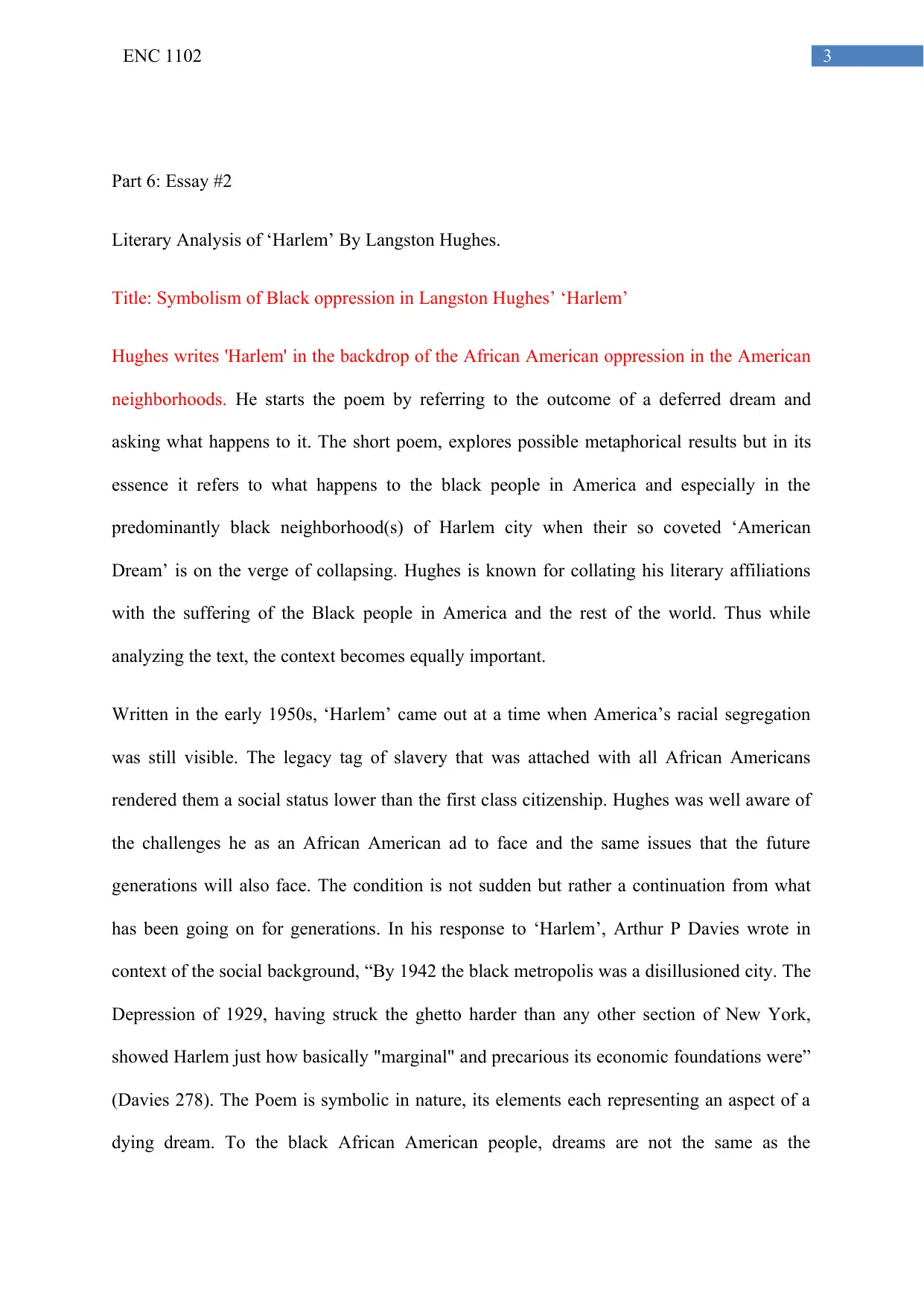
3ENC 1102
Part 6: Essay #2
Literary Analysis of ‘Harlem’ By Langston Hughes.
Title: Symbolism of Black oppression in Langston Hughes’ ‘Harlem’
Hughes writes 'Harlem' in the backdrop of the African American oppression in the American
neighborhoods. He starts the poem by referring to the outcome of a deferred dream and
asking what happens to it. The short poem, explores possible metaphorical results but in its
essence it refers to what happens to the black people in America and especially in the
predominantly black neighborhood(s) of Harlem city when their so coveted ‘American
Dream’ is on the verge of collapsing. Hughes is known for collating his literary affiliations
with the suffering of the Black people in America and the rest of the world. Thus while
analyzing the text, the context becomes equally important.
Written in the early 1950s, ‘Harlem’ came out at a time when America’s racial segregation
was still visible. The legacy tag of slavery that was attached with all African Americans
rendered them a social status lower than the first class citizenship. Hughes was well aware of
the challenges he as an African American ad to face and the same issues that the future
generations will also face. The condition is not sudden but rather a continuation from what
has been going on for generations. In his response to ‘Harlem’, Arthur P Davies wrote in
context of the social background, “By 1942 the black metropolis was a disillusioned city. The
Depression of 1929, having struck the ghetto harder than any other section of New York,
showed Harlem just how basically "marginal" and precarious its economic foundations were”
(Davies 278). The Poem is symbolic in nature, its elements each representing an aspect of a
dying dream. To the black African American people, dreams are not the same as the
Part 6: Essay #2
Literary Analysis of ‘Harlem’ By Langston Hughes.
Title: Symbolism of Black oppression in Langston Hughes’ ‘Harlem’
Hughes writes 'Harlem' in the backdrop of the African American oppression in the American
neighborhoods. He starts the poem by referring to the outcome of a deferred dream and
asking what happens to it. The short poem, explores possible metaphorical results but in its
essence it refers to what happens to the black people in America and especially in the
predominantly black neighborhood(s) of Harlem city when their so coveted ‘American
Dream’ is on the verge of collapsing. Hughes is known for collating his literary affiliations
with the suffering of the Black people in America and the rest of the world. Thus while
analyzing the text, the context becomes equally important.
Written in the early 1950s, ‘Harlem’ came out at a time when America’s racial segregation
was still visible. The legacy tag of slavery that was attached with all African Americans
rendered them a social status lower than the first class citizenship. Hughes was well aware of
the challenges he as an African American ad to face and the same issues that the future
generations will also face. The condition is not sudden but rather a continuation from what
has been going on for generations. In his response to ‘Harlem’, Arthur P Davies wrote in
context of the social background, “By 1942 the black metropolis was a disillusioned city. The
Depression of 1929, having struck the ghetto harder than any other section of New York,
showed Harlem just how basically "marginal" and precarious its economic foundations were”
(Davies 278). The Poem is symbolic in nature, its elements each representing an aspect of a
dying dream. To the black African American people, dreams are not the same as the
Secure Best Marks with AI Grader
Need help grading? Try our AI Grader for instant feedback on your assignments.
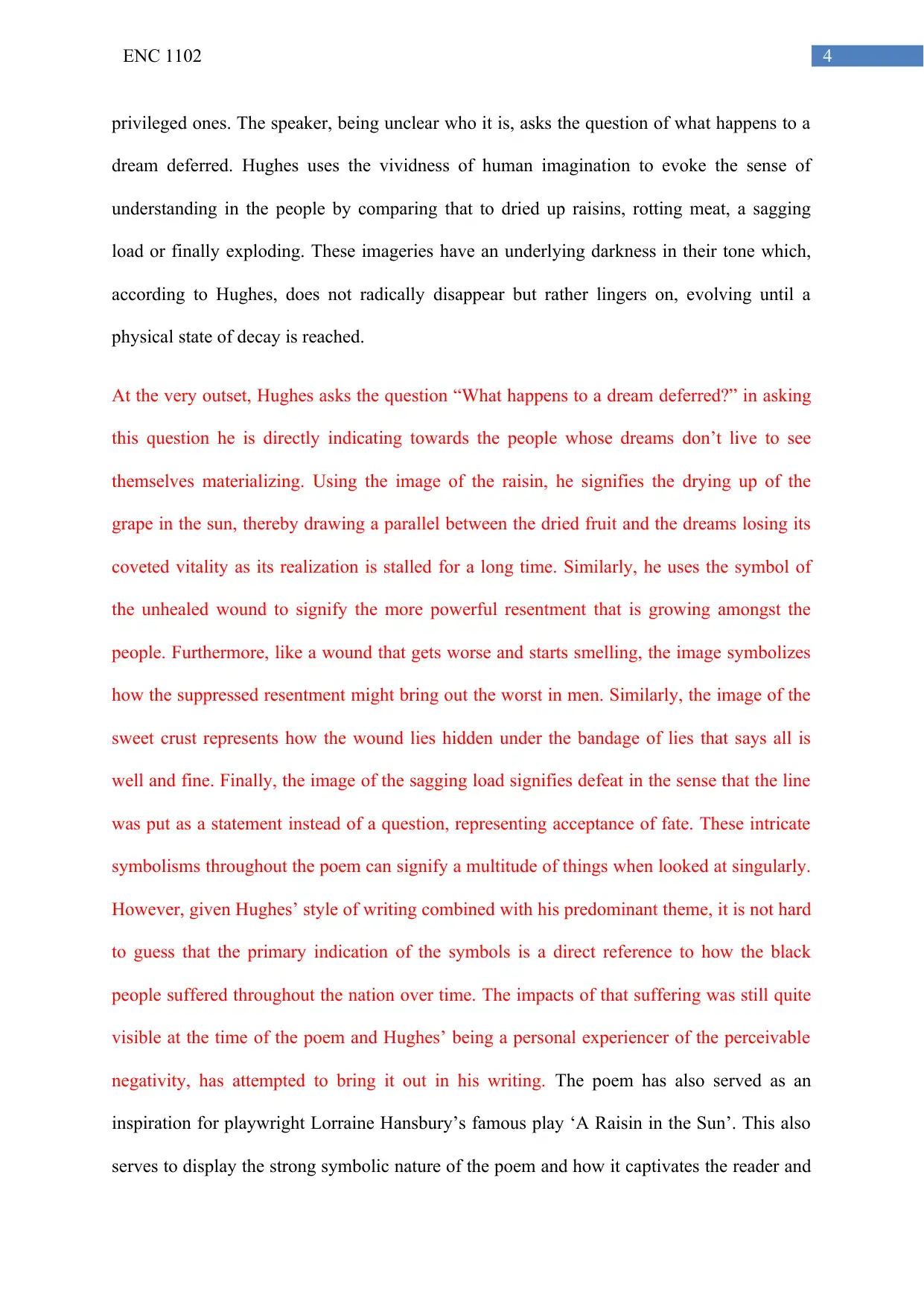
4ENC 1102
privileged ones. The speaker, being unclear who it is, asks the question of what happens to a
dream deferred. Hughes uses the vividness of human imagination to evoke the sense of
understanding in the people by comparing that to dried up raisins, rotting meat, a sagging
load or finally exploding. These imageries have an underlying darkness in their tone which,
according to Hughes, does not radically disappear but rather lingers on, evolving until a
physical state of decay is reached.
At the very outset, Hughes asks the question “What happens to a dream deferred?” in asking
this question he is directly indicating towards the people whose dreams don’t live to see
themselves materializing. Using the image of the raisin, he signifies the drying up of the
grape in the sun, thereby drawing a parallel between the dried fruit and the dreams losing its
coveted vitality as its realization is stalled for a long time. Similarly, he uses the symbol of
the unhealed wound to signify the more powerful resentment that is growing amongst the
people. Furthermore, like a wound that gets worse and starts smelling, the image symbolizes
how the suppressed resentment might bring out the worst in men. Similarly, the image of the
sweet crust represents how the wound lies hidden under the bandage of lies that says all is
well and fine. Finally, the image of the sagging load signifies defeat in the sense that the line
was put as a statement instead of a question, representing acceptance of fate. These intricate
symbolisms throughout the poem can signify a multitude of things when looked at singularly.
However, given Hughes’ style of writing combined with his predominant theme, it is not hard
to guess that the primary indication of the symbols is a direct reference to how the black
people suffered throughout the nation over time. The impacts of that suffering was still quite
visible at the time of the poem and Hughes’ being a personal experiencer of the perceivable
negativity, has attempted to bring it out in his writing. The poem has also served as an
inspiration for playwright Lorraine Hansbury’s famous play ‘A Raisin in the Sun’. This also
serves to display the strong symbolic nature of the poem and how it captivates the reader and
privileged ones. The speaker, being unclear who it is, asks the question of what happens to a
dream deferred. Hughes uses the vividness of human imagination to evoke the sense of
understanding in the people by comparing that to dried up raisins, rotting meat, a sagging
load or finally exploding. These imageries have an underlying darkness in their tone which,
according to Hughes, does not radically disappear but rather lingers on, evolving until a
physical state of decay is reached.
At the very outset, Hughes asks the question “What happens to a dream deferred?” in asking
this question he is directly indicating towards the people whose dreams don’t live to see
themselves materializing. Using the image of the raisin, he signifies the drying up of the
grape in the sun, thereby drawing a parallel between the dried fruit and the dreams losing its
coveted vitality as its realization is stalled for a long time. Similarly, he uses the symbol of
the unhealed wound to signify the more powerful resentment that is growing amongst the
people. Furthermore, like a wound that gets worse and starts smelling, the image symbolizes
how the suppressed resentment might bring out the worst in men. Similarly, the image of the
sweet crust represents how the wound lies hidden under the bandage of lies that says all is
well and fine. Finally, the image of the sagging load signifies defeat in the sense that the line
was put as a statement instead of a question, representing acceptance of fate. These intricate
symbolisms throughout the poem can signify a multitude of things when looked at singularly.
However, given Hughes’ style of writing combined with his predominant theme, it is not hard
to guess that the primary indication of the symbols is a direct reference to how the black
people suffered throughout the nation over time. The impacts of that suffering was still quite
visible at the time of the poem and Hughes’ being a personal experiencer of the perceivable
negativity, has attempted to bring it out in his writing. The poem has also served as an
inspiration for playwright Lorraine Hansbury’s famous play ‘A Raisin in the Sun’. This also
serves to display the strong symbolic nature of the poem and how it captivates the reader and

5ENC 1102
enlightens them about the horrible context of suffering and poverty that is associated with
Black Lives in America.
enlightens them about the horrible context of suffering and poverty that is associated with
Black Lives in America.
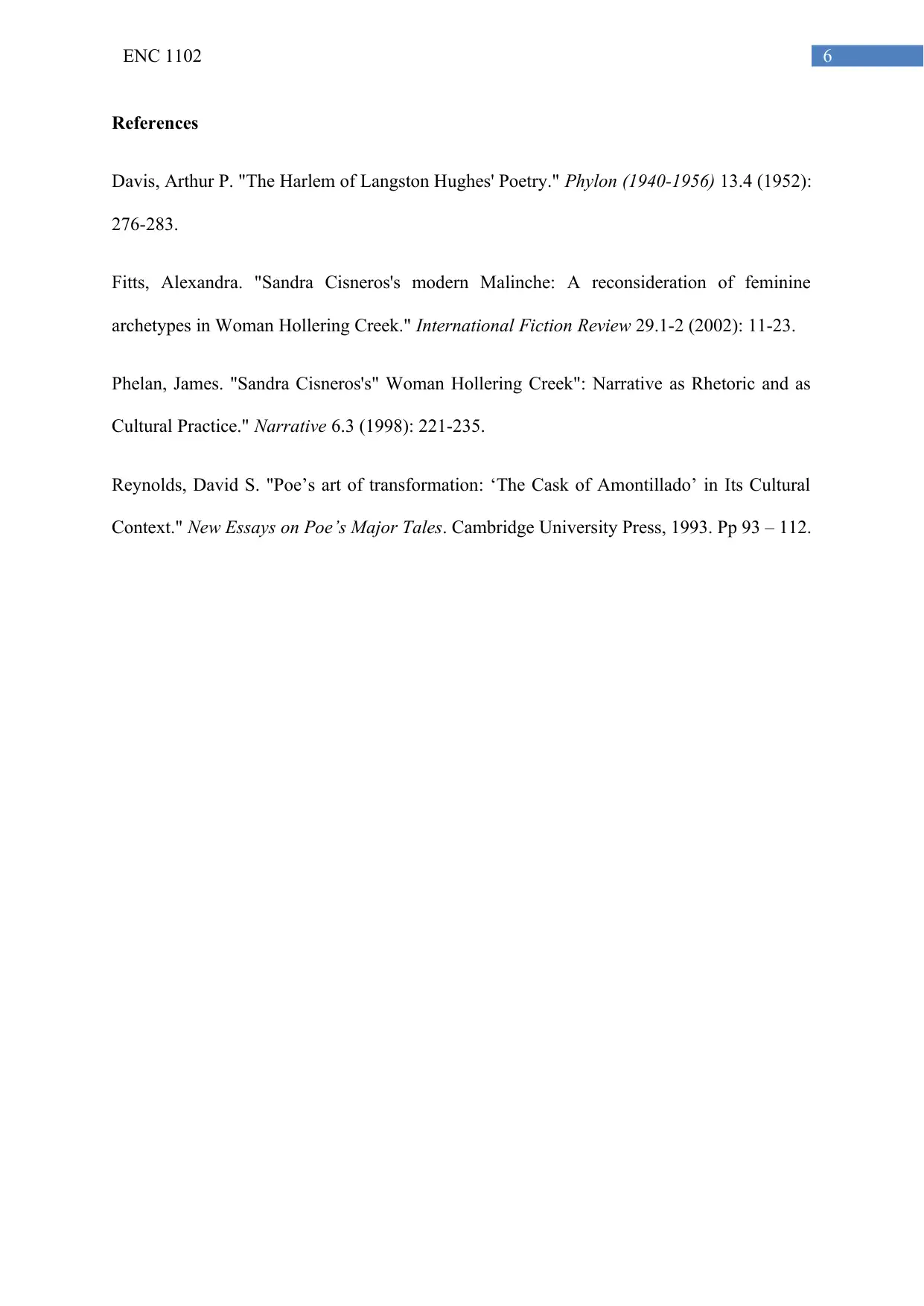
6ENC 1102
References
Davis, Arthur P. "The Harlem of Langston Hughes' Poetry." Phylon (1940-1956) 13.4 (1952):
276-283.
Fitts, Alexandra. "Sandra Cisneros's modern Malinche: A reconsideration of feminine
archetypes in Woman Hollering Creek." International Fiction Review 29.1-2 (2002): 11-23.
Phelan, James. "Sandra Cisneros's" Woman Hollering Creek": Narrative as Rhetoric and as
Cultural Practice." Narrative 6.3 (1998): 221-235.
Reynolds, David S. "Poe’s art of transformation: ‘The Cask of Amontillado’ in Its Cultural
Context." New Essays on Poe’s Major Tales. Cambridge University Press, 1993. Pp 93 – 112.
References
Davis, Arthur P. "The Harlem of Langston Hughes' Poetry." Phylon (1940-1956) 13.4 (1952):
276-283.
Fitts, Alexandra. "Sandra Cisneros's modern Malinche: A reconsideration of feminine
archetypes in Woman Hollering Creek." International Fiction Review 29.1-2 (2002): 11-23.
Phelan, James. "Sandra Cisneros's" Woman Hollering Creek": Narrative as Rhetoric and as
Cultural Practice." Narrative 6.3 (1998): 221-235.
Reynolds, David S. "Poe’s art of transformation: ‘The Cask of Amontillado’ in Its Cultural
Context." New Essays on Poe’s Major Tales. Cambridge University Press, 1993. Pp 93 – 112.
1 out of 7
Your All-in-One AI-Powered Toolkit for Academic Success.
+13062052269
info@desklib.com
Available 24*7 on WhatsApp / Email
![[object Object]](/_next/static/media/star-bottom.7253800d.svg)
Unlock your academic potential
© 2024 | Zucol Services PVT LTD | All rights reserved.